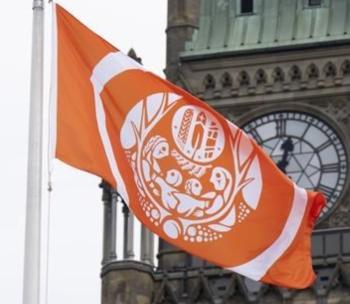Image Caption
Summary
Local Journalism Initiative Reporter
Windspeaker.com
The raising of the Survivors’ Flag this morning on Parliament Hill ended with a victory song performed by the Spirit Wolf Singers.
“We’re still here. We’re still here and we’ll always be here,” said Claudette Commanda, Algonquin Anishinabe from Kitigan Zibi Anishinabeg First Nation and host of the event. She said the request to end the special event with a victory song instead of a closing prayer came from Elder and survivor Eugene Arcand and was “appropriate.”
The flag commemorates and honours survivors of residential schools along with their families and communities. It was developed through consultation and collaboration with Inuit, Mi’kmaq, Atikamekw, Cree, Ojibway, Dakota, Mohawk, Dene, Nuu-chah-nulth, Secwepemc, and Métis survivors.
“We are strong. We are building beautiful futures with our communities for future generations,” said Inuk survivor Dr. Levinia Brown, a former MLA for Ranklin Inlet.
Arcand and Brown joined with fellow survivors Florence Cote and Jimmy Durocher to help Prime Minister Justin Trudeau raise the flag.
Trudeau said the flag flying near the West Block is outside the window of the room Cabinet meets in and “as we deliberate on the important path forward of this country (we will) be reminded that every child matters and the work that we need to do needs to stay front and centre.”
“Today we raise the Survivors’ Flag high over these colonial buildings where lawmakers are now listening to our truths and seeking to work together towards reconciliation,” said Durocher, a Métis and Cree Elder. “We must never ever forget those children, those beautiful babies that were found in unmarked graves.”
Arcand, Cree from Muskeg Lake First Nation, who spent 11 years in two different residential schools in Saskatchewan, said the flag would not be flying if it had not been for the 215 unmarked graves revealed at the Kamloops Indian Residential School in May 2021.
“The 215 woke up the world and all of a sudden they wanted to learn more. All of a sudden residential school survivors were validated. Everything we had been saying is now considered to be the truth. So I applaud all of us who have helped those 215 and all subsequent unmarked graves and missing children who have been located but will continue to be located,” he said.
Arcand and Durocher both made it clear that the flag, which was first raised last September in a special ceremony and now relocated to Parliament Hill today, did not mean the work of truth-telling was complete.
“Everybody wants to jump to reconciliation. Be careful with that. Short cuts don’t work. Until we all deal with the truth and come up with the alternatives that are workable for everyone, reconciliation will not be achieved,” said Arcand.
He pointed out that many of the 94 Calls to Action outlined in the 2015 final report of the Truth and Reconciliation on the legacy of Indian residential schools had yet to be met.
Durocher reminded Trudeau and Crown-Indigenous Relations Minister Marc Miller that the Ile-a-la-Crosse residential school in Saskatchewan had not been included in the Indian Residential School Settlement Agreement of 2006. Durocher is a day school survivor of Ile-a-la-Crosse. He implored Trudeau and Miller to move on the issue, pointing out he was 82 years old and very few of those who attended that school were still alive today.
Durocher and Arcand joined Trudeau in encouraging all Canadians to take steps towards truth finding and reconciliation.
“Reconciliation is not just about Indigenous Canadians and government while Canadians encourage and watch from the distance. Reconciliation is about each and every one of us who live on this land, who are accountable to the generations that came before and responsible for the generations still to come,” said Trudeau.
Durocher said he was hopeful.
“I have seen more and more Canadians eager to learn the truth and find out what they can do for reconciliation … That’s where we as a collective, we as the survivors need to educate the rest of Canada (about) what happened,” said Durocher.
Stephanie Scott, executive director of the National Centre for Truth and Reconciliation, said the flag showed the “hope for the future. The hope that the seeds that rest below the soil will some day sprout and bloom again as prophesized by our people.”
The Survivors' Flag will continue to fly on Parliament Hill until a permanent home is determined.
Local Journalism Initiative Reporters are supported by a financial contribution made by the Government of Canada.

